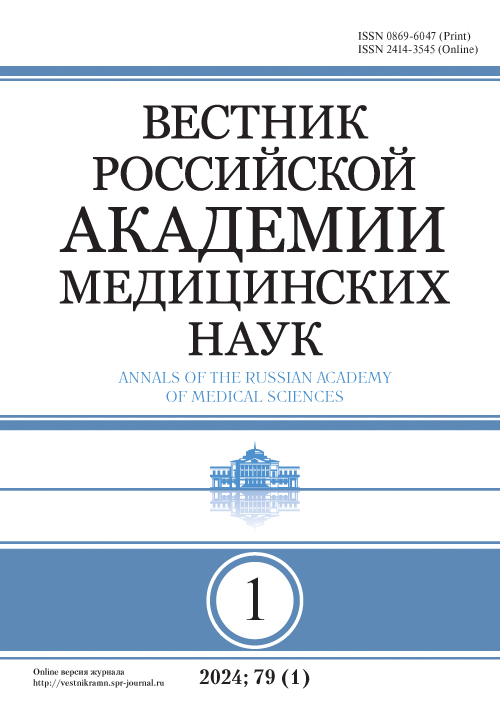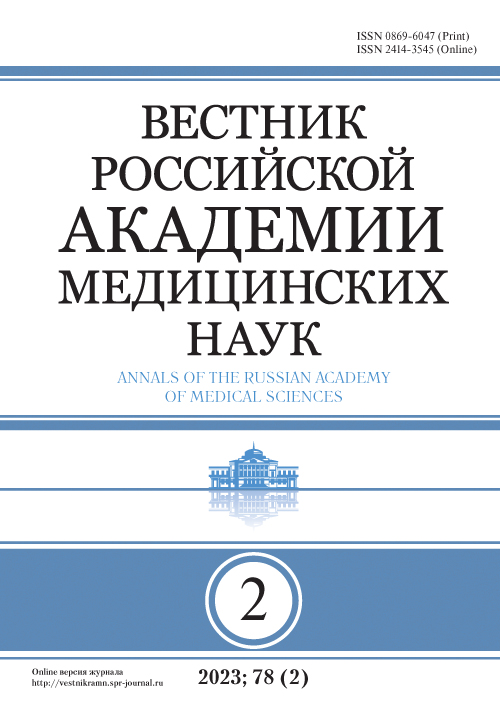Association of Calcium Index and Myocardial Blood Flow in Non-Obstructive Atherosclerotic Lesion of the Coronary Arteries
- Authors: Maltseva A.N.1, Kopeva K.V.1, Mochula A.V.1, Grakova E.V.1, Zavadovsky K.V.1, Popov S.V.1
-
Affiliations:
- Cardiology Research Institute, Tomsk National Research Medical Center, Russian Academy of Sciences
- Issue: Vol 78, No 2 (2023)
- Pages: 85-95
- Section: CARDIOLOGY AND CARDIOVASCULAR SURGERY: CURRENT ISSUES
- URL: https://vestnikramn.spr-journal.ru/jour/article/view/3513
- DOI: https://doi.org/10.15690/vramn3513
- ID: 3513
Cite item
Abstract
Background. Over the past few years, scientific data have demonstrated that patients with non-obstructive coronary artery disease can have high risk for adverse cardiovascular events (ACE) despite the absence of severe coronary obstruction. From this point of view, some patients require special monitoring and treatment; we have to find new methods for stratification of the risk of ACE. Aims — to study the association of coronary artery calcification (CCA) with indicators of myocardial blood flow (MBF) and myocardial flow reserve (MFR) in patients with non-obstructive coronary artery disease (CAD). Methods. The study included patients (n = 52) with non-obstructive CAD (< 50%), identified by CCTA. All patients received dynamic myocardial SPECT according to the two-day “rest-stress” protocol with the radiopharmaceutical agent 99mTc-methoxy-isobutyl-isotnitrile and the pharmacological stress-test (adenosine triphosphate 160 mcg/kg/min) to determine quantitative indicators of MBF and MFR. Depending on the calcium index (CI), three groups of patients were formed: 1 — without CCA (CI = 0 Agatston units), 19 patients; 2 — Mild CCA (CI = 1–100 Agatston units), 21 patients; 3 — Moderate CCA (CI = 101–400 Agatston units), 12 patients. Results. The study included 52 patients (age 55.0 ± 9.8 years, 36 men). The groups differed statistically significantly (p < 0.05) in terms of quantitative scintigraphic parameters: stress-MBF, MFR and ΔMBF. When analyzing the groups in pairs, it was found that stress-MBF and ΔMBF were significantly lower in the group with moderate CCA compared to the group without CCA, and MFR was lower in the group with moderate CCA compared to the groups without CCA and with mild CCA. Correlation analysis revealed significant relationships between CI and scintigraphic parameters: stress-MBF (ρ = –0.46; p = 0.003), MFR (ρ = –0.48; p = 0.001), ΔMBF (ρ = –0.48; p = 0.0008), SSS (ρ = 0.34; p = 0.02) and SDS (ρ = 0.28; p = 0.046). Conclusions. Even with non-obstructive CAD, identified by CCTA, there is a decrease in MBF and MFR inversely proportional to the level of CI, which can be considered as an early marker of impaired vasodilation reserve of the vascular wall, which develops in atherosclerosis of the coronary artery.
Full Text
About the authors
Alina N. Maltseva
Cardiology Research Institute, Tomsk National Research Medical Center, Russian Academy of Sciences
Author for correspondence.
Email: maltseva.alina.93@gmail.com
ORCID iD: 0000-0002-1311-0378
SPIN-code: 6213-3736
Post-Graduate Student, Junior Researcher
Russian Federation, TomskKristina V. Kopeva
Cardiology Research Institute, Tomsk National Research Medical Center, Russian Academy of Sciences
Email: kristin-kop@inbox.ru
ORCID iD: 0000-0002-2285-6438
SPIN-code: 5520-1140
MD, PhD, Researcher
Russian Federation, TomskAndrew V. Mochula
Cardiology Research Institute, Tomsk National Research Medical Center, Russian Academy of Sciences
Email: mochula.andrew@gmail.com
ORCID iD: 0000-0003-0883-466X
SPIN-code: 7635-6558
MD, PhD, Senior Researcher
Russian Federation, TomskElena V. Grakova
Cardiology Research Institute, Tomsk National Research Medical Center, Russian Academy of Sciences
Email: vgelen1970@gmail.com
ORCID iD: 0000-0003-4019-3735
SPIN-code: 7281-8120
MD, PhD, Leading Researcher
Russian Federation, TomskKonstantin V. Zavadovsky
Cardiology Research Institute, Tomsk National Research Medical Center, Russian Academy of Sciences
Email: konstz@cardio-tomsk.ru
ORCID iD: 0000-0002-1513-8614
SPIN-code: 5081-3495
MD, PhD
Russian Federation, TomskSergey V. Popov
Cardiology Research Institute, Tomsk National Research Medical Center, Russian Academy of Sciences
Email: psv@cardio-tomsk.ru
ORCID iD: 0000-0002-9050-4493
SPIN-code: 6853-7180
MD, PhD, Professor, Academician of the RAS
Russian Federation, TomskReferences
- Huang F-Y, Huang B-T, Lv W-Y, et al. The prognosis of patients with nonobstructive coronary artery disease versus normal arteries determined by invasive coronary angiography or computed tomography coronary angiography: A systematic review. Medicine (Baltimore). 2016;95(11):e3117. doi: https://doi.org/10.1097/MD.0000000000003117
- Havel M, Koranda P, Kincl V, et al. Additional value of the coronary artery calcium score in patients for whom myocardial perfusion imaging is challenging. Kardiol Pol. 2019;77(4):458–464. doi: https://doi.org/10.5603/KP.a2019.0037
- Knuuti J, Wijns W, Saraste A, et al. ESC Scientific Document Group. ESC Guidelines for the diagnosis and management of chronic coronary syndromes. Eur Heart J. 2020;41(3):407–477. doi: https://doi.org/10.1093/eurheartj/ehz425
- Барбараш О.Л., Карпов Ю.А., Кашталап В.В., и др. Стабильная ишемическая болезнь сердца. Клинические рекомендации 2020 // Российский кардиологический журнал. — 2020. — Т. 25. — № 11. — С. 4076. [Barbarash OL, Karpov YuA, Kashtalap VV, et al. 2020 Clinical practice guidelines for Stable coronary artery disease. Russian Journal of Cardiology. 2020;25(11):4076. (In Russ.)]. doi: https://doi.org/10.15829/1560-4071-2020-4076
- Журавлев К.Н., Васильева Е.Ю., Синицын В.Е., др. Кальциевый индекс как скрининговый метод диагностики сердечно-сосудистых заболеваний // Российский кардиологический журнал. — 2019. — Т. 24. — № 12. — С. 153–161. [Zhuravlev KN, Vasilieva EYu, Sinitsyn VE, et al. Calcium score as a screening method for cardiovascular disease diagnosis. Russian Journal of Cardiology. 2019;24(12):153–161. (In Russ.)]. doi: https://doi.org/10.15829/1560-4071-2019-12-153-161
- Padro T, Manfrini O, Bugiardini R, et al. ESC Working Group on Coronary Pathophysiology and Microcirculation position paper on “coronary microvascular dysfunction in cardiovascular disease”. Cardiovasc Res. 2020;116(4):741–755. doi: https://doi.org/10.1093/cvr/cvaa003
- Шматова Е.Н., Гринштейн Ю.И. Микроваскулярная стенокардия: патогенез, клиника, диагностика и принципы терапии // РМЖ. Медицинское обозрение. — 2020. — Т. 4. — № 7. — С. 425–430. [Shmatova EN, Grinshtein YuI. Microvascular angina: pathogenesis, clinical picture, diagnosis and therapy tactics. Russian Medical Inquiry. 2020;4(7):425–430. (In Russ.)]. doi: https://doi.org/10.32364/2587-6821-2020-4-7-425-430
- Zavadovsky KV, Mochula AV, Maltseva AN, et al. The current status of CZT SPECT myocardial blood flow and reserve assessment: Tips and tricks. J Nucl Cardiol. 2022;29(6):3137–3151. doi: https://doi.org/10.1007/s12350-021-02620-y
- Леонова И.А., Захарова О.В., Болдуева С.А. Нарушения эндотелий-зависимой вазодилатации у больных с микрососудистой стенокардией // РМЖ. Медицинское обозрение. — 2022. — Т. 6. — № 8. — С. 427–432. [Leonova IA, Zakharova OV, Boldueva SA. Disorders of endothelium-dependent vasodilation in patients with microvascular angina. Russian Medical Inquiry. 2022;6(8):427–432. (In Russ.)]. doi: https://doi.org/10.32364/2587-6821-2022-6-8-427-432
- Curillova Z, Yaman BF, Dorbala S, et al. Quantitative relationship between coronary calcium content and coronary flow reserve as assessed by integrated PET/CT imaging. Eur J Nucl Med Mol Imaging. 2009;36(10):1603–1610. doi: https://doi.org/10.1007/s00259-009-1121-1
- Aljizeeri A, Ahmed AI, Alfaris MA, et al. Myocardial Flow Reserve and Coronary Calcification in Prognosis of Patients with Suspected Coronary Artery Disease. JACC Cardiovasc Imaging. 2021;14(12):2443–2452. doi: https://doi.org/10.1016/j.jcmg.2021.01.024
- Patel KK, Peri-Okonny PA, Qarajeh R, et al. Prognostic relationship between coronary artery calcium score, perfusion defects, and myocardial blood flow reserve in patients with suspected coronary artery disease. Circ Cardiovasc Imaging. 2022;15(4):e012599. doi: https://doi.org/10.1161/CIRCIMAGING.121.012599
- Agatston AS, Janowitz WR, Hildner FJ, et al. Quantification of coronary artery calcium using ultrafast computed tomography. J Am Coll Cardiol. 1990;15(4):827–832. doi: https://doi.org/10.1016/0735-1097(90)90282-t
- Завадовский К.В., Мочула А.В., Врублевский А.В., и др. Роль нагрузочной динамической однофотонной эмиссионной компьютерной томографии с определением резерва миокардиального кровотока в оценке значимости стенозов коронарных артерий // Российский кардиологический журнал. — 2019. — Т. 24. — № 12. — С. 40–46. [Zavadovsky KV, Mochula AV, Vrublevsky AV, et al. Role of stress in dynamic single-photon emission computed tomography with myocardial perfusion reserve determination in assessing the severity of coronary artery stenosis. Russian Journal of Cardiology. 2019;24(12):40–46 (In Russ.)]. doi: https://doi.org/10.15829/1560-4071-2019-12-40-46
- Bailly M, Thibault F, Courtehoux M, et al. Added Value of Myocardial Blood Flow Quantification and Calcium Scoring During CZT SPECT Myocardial Perfusion Imaging for Coronary Artery Disease Screening. Clin Nucl Med. 2019;44(11):e617–e619. doi: https://doi.org/10.1097/RLU.0000000000002709
- Greenland P, Blaha MJ, Budoff MJ, et al. Coronary Calcium Score and Cardiovascular Risk. J Am Coll Cardiol. 2018;72(4):434–447. doi: https://doi.org/10.1016/j.jacc.2018.05.027
- Мальцева А.Н., Мочула А.В., Копьева К.В., и др. Радионуклидные методы исследования в диагностике микроваскулярной дисфункции при необструктивном атеросклеротическом поражении коронарных артерий // Российский кардиологический журнал. — 2021. — Т. 26. — № 12. — С. 181–188. [Maltseva AN, Mochula AV, Kopyeva KV, et al. Radionuclide imaging methods in the diagnosis of microvascular dysfunction in non-obstructive coronary artery disease. Russian Journal of Cardiology. 2021;26(12):181–188. (In Russ.)]. doi: https://doi.org/10.15829/1560-4071-2021-4746
- Bairey Merz CN, Pepine CJ, Shimokawa H, et al. Treatment of coronary microvascular dysfunction. Cardiovasc Res. 2020;116(4):856–870. doi: https://doi.org/10.1093/cvr/cvaa006
- Lee SE, Chang HJ, Sung JM, et al. Effects of Statins on Coronary Atherosclerotic Plaques: The PARADIGM Study. JACC Cardiovasc Imaging. 2018;11(10):1475–1484. doi: https://doi.org/10.1016/j.jcmg.2018.04.015
- Lee SE, Sung JM, Andreini D, et al. Differential association between the progression of coronary artery calcium score and coronary plaque volume progression according to statins: the Progression of AtheRosclerotic PlAque DetermIned by Computed TomoGraphic Angiography Imaging (PARADIGM) study. Eur Heart J Cardiovasc Imaging. 2019;20(11):1307–1314. doi: https://doi.org/10.1093/ehjci/jez022
Supplementary files













